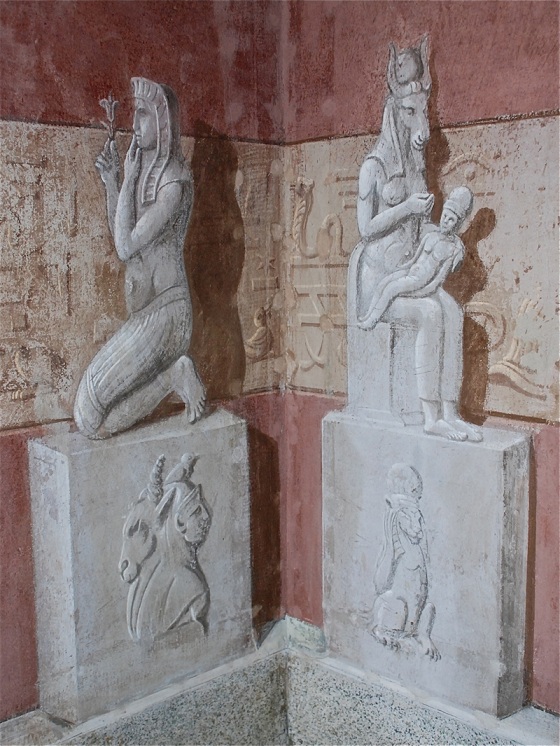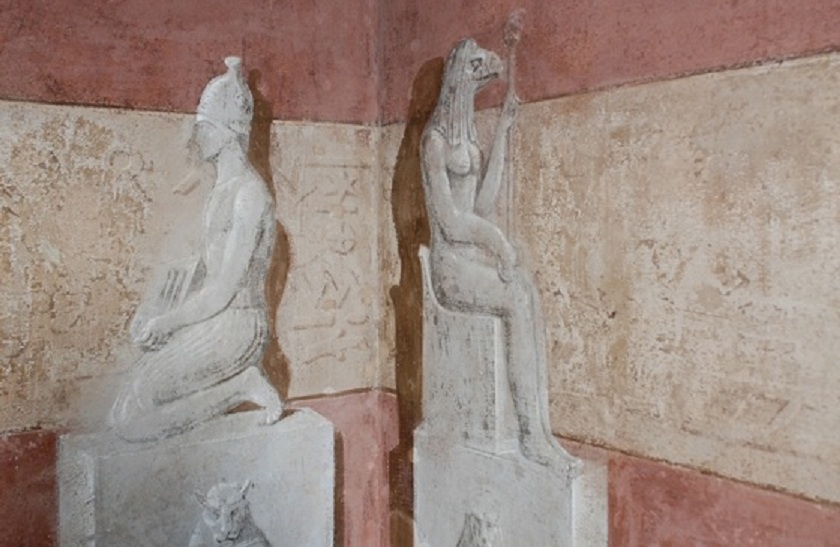
© Rossella LorenziThe Egyptian room of Casalbuttano.
Strange hieroglyphs and representations of Egyptian gods and goddesses have been found in the middle of the Po valley in northern Italy, revealing a unique example of Egyptomania.
Found in Casalbuttano ed Uniti, a village some 10 miles north of Cremona, the Egyptian-inspired motifs materialized as restorers removed the tapestry in a room of Palazzo Turina, an 18th century building which now houses the town hall.
A blue starry ceiling emerged, while walls decorated with pink and cream colored bands revealed a wealth of hieroglyphs.
Painted with stunning
trompe l'oeil effects to produce the illusion of real statues, depictions of Egyptian god and goddesses emerged at the room corners.
"It has been an amazing discovery. The animal glue used for the tapestry actually preserved the frescoes, which only needed some basic cleaning," Virginia Bocciola, one of the architects who carried the restoration, told Discovery News.
Although archaeologists found the motifs in 2006, it remained relatively unknown until recently when Annamaria Ravagnan, in charge of the Lombardy region's museum system, asked experts to study the unusually decorated room.
"In Lombardy we have several villas which feature rooms decorated in Egyptian style. But none look like the Casalbuttano chamber," Ravagnan told Discovery News.
Jean-Marcel Humbert, Heritage General Curator and General Inspector at the French Direction of Museums (Ministry of Culture) agrees.
"There are several rooms of this type in Italy and around the world. All are different, because of the period, because of the style, because of the size. So the Casalbuttano one is unique," he told Discovery News.
Humbert, who specializes in Egyptology and is one of the leading experts of Egyptomania -- the fascination for all things Egyptian -- will publish a detailed study of the room by the beginning of 2012.

© Rossella LorenziThe Egyptian room of Casalbuttano.
"It is especially interesting because of the use of hieroglyphics and the adaptations which were made," Humbert said.
Indeed, the painter reworked Egyptian imagery producing bizarre scenes which are difficult to interpret.
Although the hieroglyphs are real, the way they are put together result in an incomprehensible text, while the deities mix clear Egyptian details with completely obscure features.
"The study is quite complicated, more than for other rooms, because it is not easy to find the referring models," Humbert said.
Some of the deities, identified as Sekhmet, Taweret, Hathor and Horus, feature details totally unrelated with their role of Egyptian divinities.
For example, Sekhmet, the lion-headed goddess of healing, sits on what appears to be an Etruscan chair inscribed with meaningless hieroglyphs.
Taweret, the goddess of childbirth and fertility, usually portrayed with a hippo's head, lion arms and legs and a crocodile's tail, instead boasts a cow tail.
Not much is known about the artist who created the room.
"We know that the wealthy Turina family commissioned the decoration of the palace to some of the best artists of the time, such as Gioacchino Serangeli and Giovanni Motta," Maurizio Telli, councillor for culture at Casalbuttano, told Discovery News.
The room was most likely realized after Napoleon's military campaign from 1798 to 1801, when the Turinas, as well as many other Europeans, became fascinated with Egypt.
The ill-fated expedition produced the publication of the multi-volume
Description de l'Égypte, a collaborative work of about 160 scholars and scientists, known as the savants, as well as some 2000 artists and 400 engravers who accompanied Napoleon's soldiers.
Published first in 1809 and continuing until the final volume appeared in 1829, the
Description de l'Égypte is at the foundation for the modern Egyptology.
Although ancient Egypt had inspired fascination well before Napoleon's Egyptian campaign, the unique publication series, with its large and stunning plate illustrations, strongly contributed to the intrigue associated with Egyptian style.
Indeed, sphinxes, obelisks, pyramids and "Egyptian rooms" began to appear everywhere in Europe.
"We like to think that our Egyptian room is somewhat unique. Here the reworking of Egyptian imagery has produced some surprising results," Telli said.
The Egyptian room is now open to public under request.
Reader Comments
to our Newsletter